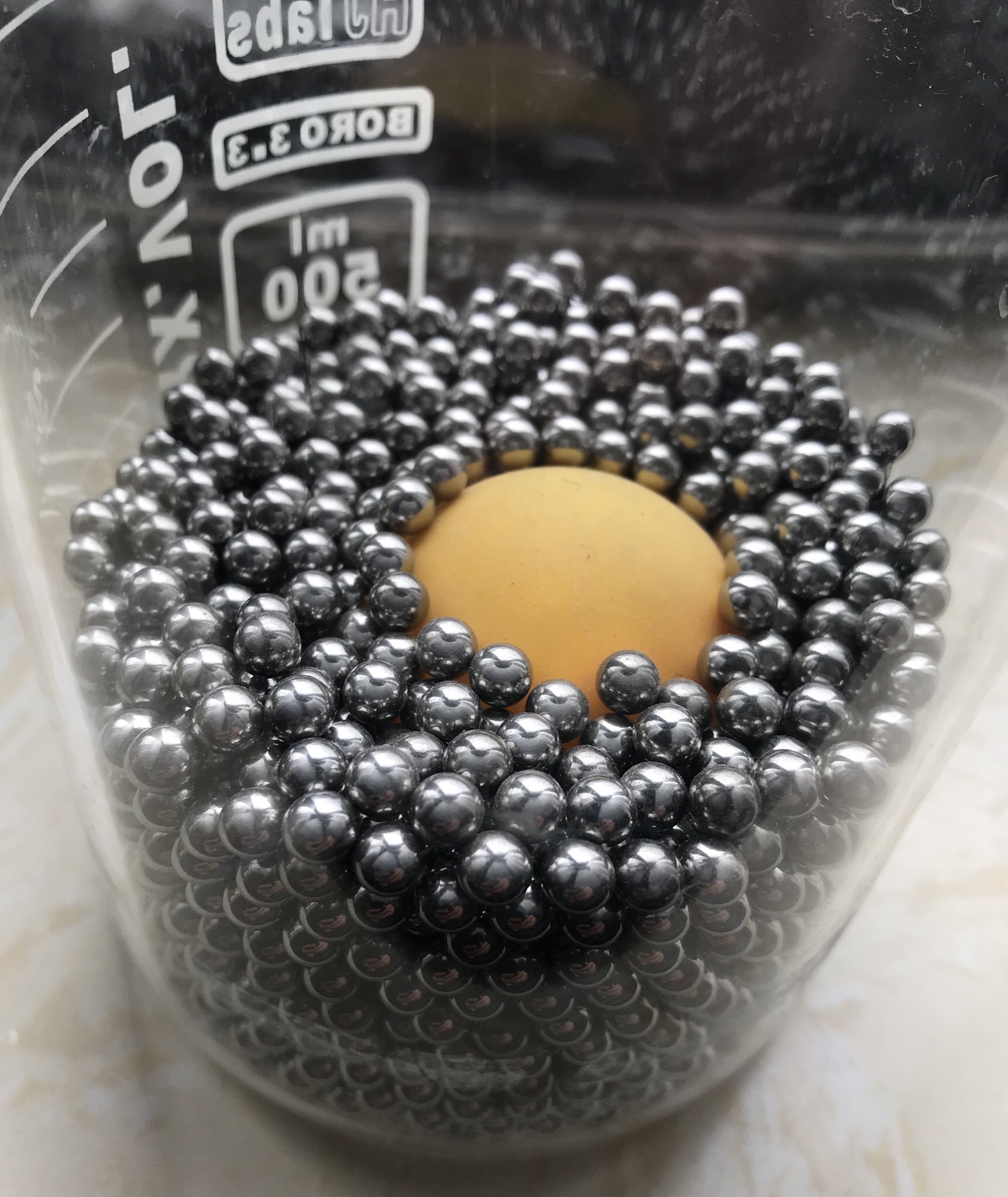Place the beaker full of steel balls and submerge the table tennis ball under the steel balls. The table tennis ball does not float up. Why does it not float up? Do table tennis balls float when the diameter of steel balls is reduced? How to calculate the buoyancy of steel balls? Would it come up without friction?
-
10$\begingroup$ Shake the bowl a little. Like Brownian motion on water molecules. $\endgroup$– Hot LicksCommented Mar 28, 2019 at 19:31
-
$\begingroup$ @HotLicks Would it come up without friction? $\endgroup$– enbinCommented Apr 1, 2019 at 22:58
-
$\begingroup$ Some of the ball bearings sit above the midline of the ping-pong ball and push down on it. Even if the ball bearings too were free of all friction they would still be locked in place by the weight other ball bearings above them. $\endgroup$– Hot LicksCommented Apr 2, 2019 at 1:56
-
$\begingroup$ @HotLicks Because there is no friction, will the bearing balls at the bottom of the table tennis ball not produce buoyancy to the table tennis ball? $\endgroup$– enbinCommented Apr 2, 2019 at 2:47
-
$\begingroup$ They will produce buoyancy, but it's not a given that this will be sufficient to overcome the force of the balls pressing down from above, especially since the balls are apt to be "locked" in place due to being wedged together. $\endgroup$– Hot LicksCommented Apr 2, 2019 at 2:53
2 Answers
The ball bearings are behaving as a solid because the forces between the steel balls (i.e. friction) are large enough to hold the balls in position relative to each other.
If you apply enough force to a solid you will cause it to fracture or to cause plastic flow. So for example if you attached a string to the ball and pulled upwards with enough force it would cause the steel balls to flow over each other and the table tennis ball would move up. The force required is related to the yield stress of the solid formed by the steel balls.
You can make the steel balls behave as a fluid by making a gas flow through them. This creates a fluidised bed. The gas pushes the steel balls apart so the friction between them is removed, and in this state the steel balls will behave like a fluid and the table tennis ball would float upwards.
Alternatively just shake the beaker. This is equivalent to adding thermal energy i.e. heating the system until it melts. If you shake the beaker you'll find the table tennis ball floats upwards.
-
8$\begingroup$ -1 Shaking the beaker will make the ball float upwards because of the size difference, not the density difference. It's a very different effect. (If you were to reverse the materials of the balls - it is the large steel ball that would end up on top) $\endgroup$– UKMonkeyCommented Mar 28, 2019 at 9:48
-
4$\begingroup$ *edit density and size (in effect density including air gaps) here's the wiki article en.wikipedia.org/wiki/Granular_convection $\endgroup$– UKMonkeyCommented Mar 28, 2019 at 9:53
-
13$\begingroup$ @UKMonkey it's both size and density. As it happens I explained the effect of size in Why do the big nuts always remain at top? The Brazil-nut Effect. $\endgroup$ Commented Mar 28, 2019 at 10:20
-
3$\begingroup$ The linked answer is good but it doesn't explain how buoyancy is different. I've actually never seen a good explanation of the mechanisms underlying buoyancy. Often it's described as if it were a fundamental force. $\endgroup$ Commented Mar 28, 2019 at 18:11
-
2$\begingroup$ Another comparison that would be interesting is how this is or is not related to how a dust particle can hover in still air for a period that is longer than would be expected given relative density to air. $\endgroup$ Commented Mar 28, 2019 at 18:17
Well, what if the steel balls were extremely small, say molecular size. In that case, the constraining annulus would look like a polished steel collar, and would likely hold down the ball even if the glass was shattered, underwater, in a swimming pool. . (The van der Waals forces, and metallic bonds, would account for that.)
But this example given, shows discreet balls of intermediate size, and unless they are magnetized, their coupling with the container is what allows restraint of the tennis ball. If THIS setup was in the bottom of a deeper pool, and the beaker was shattered, the steel balls would run radially away, and the tennis ball would pop up.
(Note: I answered this as if there was water in the beaker along with the steel balls and tennis ball. But the answer is not changed by my error.)
The term "van der Waals force" is sometimes used loosely for all intermolecular forces.
-
$\begingroup$ Can't the steel balls float a table tennis ball even if they are very small? $\endgroup$– enbinCommented Mar 28, 2019 at 18:32

